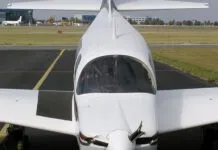I just finished reading the October 2023 issue. Thanks for the opportunity to share “The Overconfidence Beast” as a Learning Experience for your readers. Aviation Safety is a most valuable conduit for a mutual sharing of experience and expertise leading to a safer industry. Thank goodness we can learn from others.
“No Pressure” takes me back to my Air Force days when all aircrew had to go through HAI (High Altitude Indoctrination) training with a ride in a hypobaric chamber to 30,000 feet, stopping at various altitudes along the way. At each “level off,” we doffed our oxygen masks to perform a series of cognitive function tests, demonstrating how quickly hypoxia can set in. An eye-opening, educational but humbling experience, as virtually anything above 10K showed a marked decrease in my ability to do even basic addition or multiplication tasks, topped off by my time of useful consciousness at 30K being a little over 30 seconds.
And “Chain Of Events,” October’s Accident Probe installment, brought back a number of personal experiences where my bacon was saved by simply reverting to the article’s critically important theme of adherence to standard procedures. One example was when I was just about to ferry a Turbo Thrush and was called away halfway through the external. Upon return to the aircraft, I hopped into the cockpit and started my pre-start procedures, but couldn’t remember if I had completed the walkaround. I hesitated for a second and decided it wouldn’t hurt to make sure. Imagine my astonishment to find the engine air intake plug (less its red warning lanyard) still in place! I still cringe at the thought of what may have happened. Yes, a chain is only as strong as its weakest link.
—Ted Delanghe, Via email
Belts And Harnesses
 Regarding October 2023’s Accident Probe, “Chain Of Events,” I’ve been flying off and on for 62 years, and I’ve had the standard lap belt clip come silently and smoothly open more times than I can count.
Regarding October 2023’s Accident Probe, “Chain Of Events,” I’ve been flying off and on for 62 years, and I’ve had the standard lap belt clip come silently and smoothly open more times than I can count.
For example, my Mooney 231 manual trim wheel is between the seats. Simply brushing the clip with my hand or a sleeve collar may open it when returning from adjusting trim. Unless it’s quite tight, I notice nothing. Many times, I’ve noticed the belt clip open in flight without any disturbance.
My judgment is that this is a safety problem. I much prefer the old lap belts in the first glider I flew—you had to place a metal loop over a metal clip, and then pull a metal lever over center. It releases instantly when the lever is raised, but the lever must be passed through an arc in doing so.
And no one should be without either a three-point harness or a lap-belt airbag. It is so sad to die of asphyxiation because one’s face crunched into the control wheel or panel.
—Dr. Dan Johnson, Via email
Slips And Skids
Thanks for the great article, “Uncoordinated Flight,” in the October 2023 issue! The diagram on page 14 demonstrates most effectively the difference between the two types of slips.
One suggestion, though…the phrase “direction of flight” should be replaced by “ground track.” The common definition of “relative wind” states that it flows in “a direction parallel with and opposite to the direction of flight.” For this reason, the use of the existing phrase could cause confusion, as this is clearly not the case in the side slip diagram.
In that diagram, a left crosswind is “canceling out” the leftward movement of the airplane, resulting in the ground track being aligned with the runway.
Thanks again for a great article and magazine!
—David Gill, CFI, Charlotte, N.C.
Stall Warning Systems
 This is in reference to the article originally published in April 2021, “Stall Warning Systems.” I recently reread the article. In it, you mention two common systems as the vane and reed type of system. My aircraft has what although looks like a vane type of system, is really quite different in that it does not activate a micro switch. I currently fly a 1998 PA-46-350P (converted to a JetProp) commonly known as a Piper Malibu/Mirage. Original Malibus (PA-46-310P) made between 1984 and 1988 had the vane/microswitch sensor that activated an in-cockpit horn.
This is in reference to the article originally published in April 2021, “Stall Warning Systems.” I recently reread the article. In it, you mention two common systems as the vane and reed type of system. My aircraft has what although looks like a vane type of system, is really quite different in that it does not activate a micro switch. I currently fly a 1998 PA-46-350P (converted to a JetProp) commonly known as a Piper Malibu/Mirage. Original Malibus (PA-46-310P) made between 1984 and 1988 had the vane/microswitch sensor that activated an in-cockpit horn.
From 1989 onward, with the introduction of the Mirage, Piper replaced the vane/micro switch sensor with a much more sophisticated sensor (also made by Safe Flight) where a spring-loaded vane actually moves a variable reluctance transformer. The primary side of the transformer is excited by a 10-volt, 700 Hz AC signal from a lift detector “computer.” The secondary side of the transformer’s output voltage varies from zero to approximately 430 millivolts, depending on the force applied to the vane. The “computer” also has inputs from micro switches on the flap linkage and throttle lever to change horn activation depending on the flap and throttle positions (basically power on or power off).
I use the term “computer” in quotes because there is no microprocessor in the stall warning computer—just simple comparator circuits, since the tipping force on the vane to activate the horn varies a lot with flap and throttle setting. On my plane, the force activating the horn is 4.7 grams at 0 degrees flaps and power off down to 1.4 grams at full flaps and power on. The amount of force is different for each airframe and is determined by Piper at the factory and recorded in the first page of the maintenance log book.
I don’t know how many other aircraft have this type of stall warning system, but I would think there must be others. The problem is the transducer is very prone to going out of calibration by inadvertent manipulation of the vane. One PMOPA member posted on the forums that he caught a lineman connecting the anti-static ground line to the vane when he was getting refueled. The calibration tool Safe Flight sells to calibrate the system I’m told costs approx $20,000, so very few shops have one.
—Greg Wroclawski, Via email
Send your thoughts, comments or questions to avsafetymag@gmail.com.



